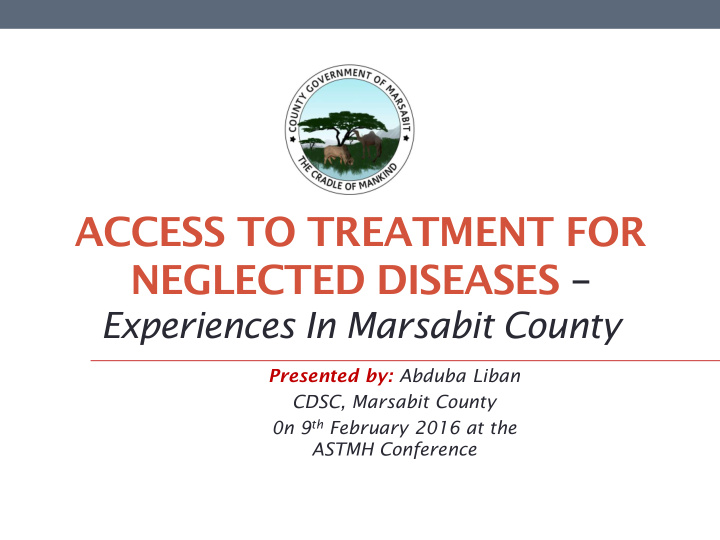



ACCESS TO TREATMENT FOR NEGLECTED DISEASES – Experiences In Marsabit County Presented by: Abduba Liban CDSC, Marsabit County 0n 9 th February 2016 at the ASTMH Conference
OUTLINE Brief county profile 1. Status of kala-azar marsabit county 2. Diagnosis and Treatment of Kala azar in Marsabit 3. Challenges of Accessing Treatment 4. Addressing the challenges at County Level 5. Way forward 6.
Marsabit County
County Profile
County Population •
Visceral leishmaniasis VL (Kala azar) Kala azar a systemic parasitic disease It is transmitted through infected female sand fly. There are three forms of leishmaniasis; Visceral leishmanaisis (VL), Cutaneous, Muco-cutaneous There are three endemic foci in kenya o Northwest Kenya - West Pokot, Baringo and Turkana o Eastern Province - Machakos, Kitui, Mwingi and kyuso o North-eastern Province - along the Somali border
Visceral Leishmaniasis in Marsabit VL is the common form leishmania in Marsabit VL is a new problem in Marsabit county There is only one treatment centre for kala azar in Marsabit – Marsabit Hospital Distance from the furthest endemic region to the centre is 500km
Kala-azar Cases by Months
Kala-azar Cases by Locations
Diagnosis & Treatment of Kala-azar in Marsabit Diagnosis and treatment is based on the Kenyan VL guidelines Diagnosis A patient should be suspected in a patient from, or visiting, an endemic area who presents with: o Fever > 2 weeks o Splenomegaly o Weight loss o Diagnosis through rapid test kits – rK39
Diagnosis & Treatment of Kala-azar in Marsabit Diagnosis and treatment is based on the Kenyan VL guidelines Treatment If patient is found positive after all differentials are ruled out, they are: Admitted in the hospital Placed on 17 day treatment with SSG & PM (first line treatment) Second line treatment - Ambisome
Challenges of Accessing Treatment Community Level Challenges Distance to the treatment centre Lack of awareness of the disease Cultural practices (seeking traditional treatments for disease) Supply and Purchase Challenges Treatments are available mainly through donations from partners Treatments are usually very expensive Treatments not usually available in KEMSA or MEDs
Challenges of Accessing Treatment Health - Worker Level Challenges Lack of training of healthworkers: o Doctors administer SSG alone and do not adhere to SSG&PM o Leading to misdiagnosis o Very few health-workers are trained in specialized procedures such as bone marrow and splenic aspirates
Addressing the challenges at County Level Improved Surveillance and Reporting: o Reported the increase to next level of health system o Reinforced the surveillance system o Made weekly data reporting mandatory Treated all confirmed cases using appropriate drugs therapy Training of hospital and health centre staff in diagnosis and treatment protocols
Addressing the challenges at County Level Advocacy Communication and Social Mobilization: o Health education to the communities. o Created awareness on leishmaniasis prevention and control measures o Development and distribution of brochures and banners o Talk shows in local radio stations Undertaken vector surveillance and control measures
Conclusions and Way forward There is need to prioritize VL and purchase of treatments and diagnostics Improved awareness creation, advocacy and communication Consistency in supplies Training of health workers at facility level on kala azar Training of health care providers in bone marrow and spleen aspirates Intensification of control measures
Field retrospective data collection, Marsabit County, May – June 2014
Traditional treatment of kala-azar cases marsabit county May-June 2014
Blood sample collection, Marsabit County, May – June 2014
Kala-azar case investigation team, Marsabit County, May – June 2014
END
Recommend
More recommend